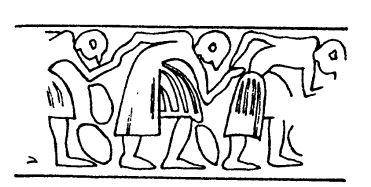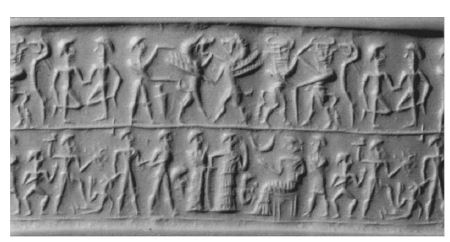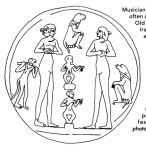Unfortunately, we do not know very much about dancing in ancient Mesopotamia. In today’s post I offer you what we do know.
On his weary search to eternal life, Gilgamesh encountered a tavern-keeper, who – as every good tavern-keeper does – gave him some advice:
O Gilgamesh, where are you wandering? The life that you seek you never will find: when the gods created mankind, death they dispensed to mankind, life they kept for themselves. But you, Gilgamesh, let your belly be full, enjoy yourself always by day and by night! Make merry each day, dance and play day and night! (Gabbay 2003)
As far as we are able to discern it from our sources, dance was considered an act of spontaneous joy in ancient Mesopotamia. We find it as a characteristic of youth, both in a positive (joy) and in a negative (irresponsibility) sense, the latter of which can be seen in a letter of the second millennium BC:
The woman has greatly aggravated the matter. In addition to dancing about every day, she has slighted us greatly by consistently behaving thoughtlessly. (Gabbay 2003)

Seal impression, 3rd millennium BC
Perhaps dancing was in this case a bad thing, because it was also associated with sexuality, particularly of young girls. In a Sumerian myth, the deities Inanna and Dumuzi have met “in lovers’ embrace”, and when the girl wants to leave, Dumuzi tells her to lie to her mother about what she has been doing. Instead of telling the truth, she must say that she was dancing with her girlfriends.
Dance was furthermore connected with the cult, especially in ceremonies for the goddess Ishtar. Some ritual texts tell us about the assinnu and the kurgarrû, who were priests who genderwise floated between the female and the male. They performed dance acts for the deity, which included the wearing of masks and possibly cross-dressing as well.

Old-Babylonian cylinder seal
Dancers are (not very often) depicted on reliefs or cylinder seals. It is hard to recognize them, and when we do, it is because they are accompanied by musicians holding musical instruments. On this cylinder seal impression, you can see in the first row, the second and third person from the left, two people dancing some kind of charleston-dance, in which they lift up one foot and touch it with the palm of their hand, while holding the hand of their partner. In the second row, the first person from the left is a so-called “bow-legged dwarf”, a depiction of a dancer which we encounter regularly. We know that he was a dancer because a parallel depiction has been found in Egypt in the form of an ivory mechanical device, whose limbs can be moved like a puppet’s.

Old-Babylonian terracotta disc
The Akkadian word for dancer was raqqidu. Other terms such as huppûm (Akkadian) or gu4-ud (Sumerian) are semantically connected with jumping. There were even some dance schools, as is attested in letters from the second millennium BC; or dancers could train in private with a dance teacher. Dancers were not only human; sometimes bears and monkeys could also perform dances. Things must have gotten quite wild in those days!
Further reading
- Collon, Dominique. “Dance in Ancient Mesopotamia.” Near Eastern Archaeology volume 66 no. 3. 2003, pp. 96-102.
- Gabbay, Uri. “Dance in Textual Sources from Ancient Mesopotamia.” Near Eastern Archaeology volume 66 no. 3. 2003, pp. 103-105.
Informative and amusing. Thank you for sharing.
LikeLike